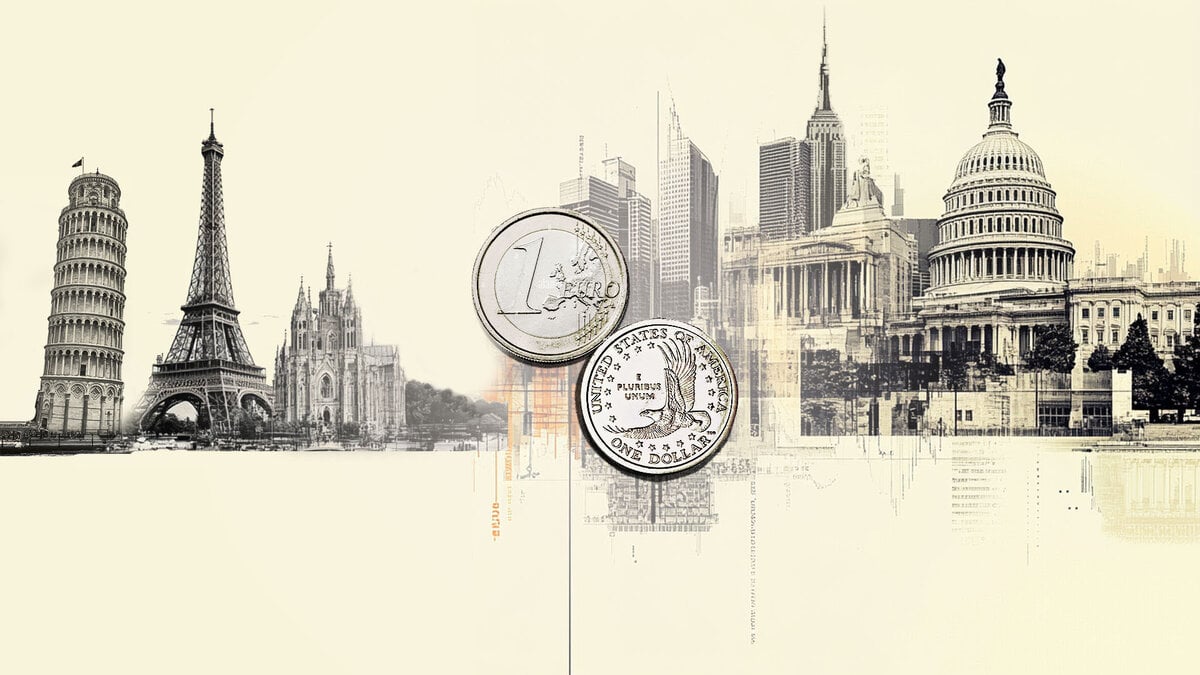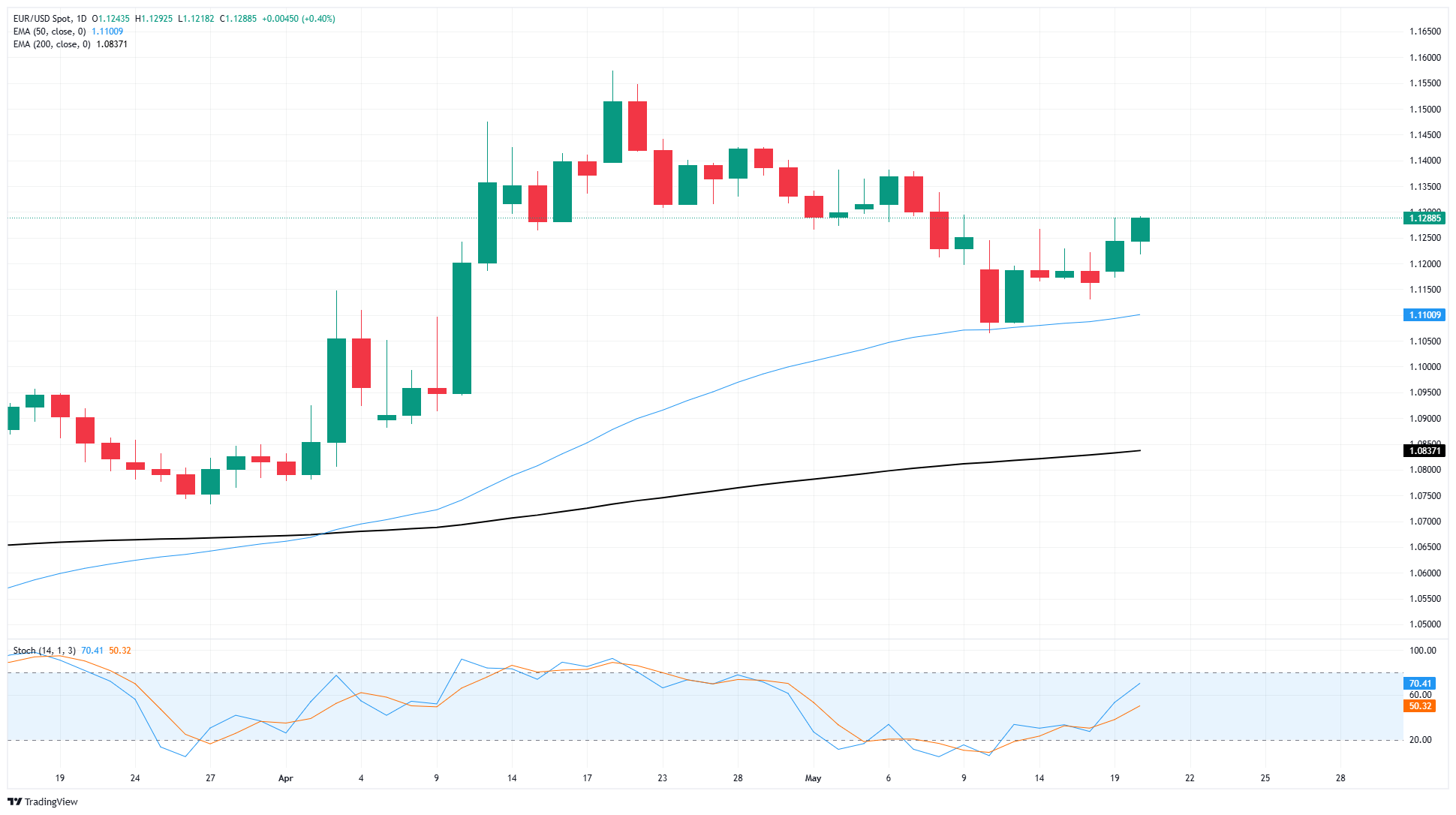Created
: 2025.05.21














![]() 2025.05.21 08:58
2025.05.21 08:58
EUR/USD caught a bounce for a second day in a row on Tuesday, bolstering the pair back toward the 1.1300 handle. Despite a near-term rise in bullish momentum bolstering the Fiber, EUR/USD remains well back from recent multi-year highs near 1.1575. The pair has found a firm technical floor from key moving averages, and overall market sentiment remains hopeful that traders will be able to keep finding reasons to hit the buy button.
European policymakers are currently wrapped up in G7 meetings, minimizing the trickle of noteworthy headlines from key EU decision-makers. Overall market sentiment remains entirely hinged on trade headlines from the US, with investors hoping that deals will be struck with the Trump administration that will encourage President Donald Trump and his staffers to take the tariff gun away from their own economy's head. Despite the overall upbeat tone in global markets, the steady drift into the unknown is beginning to limit bullish sentiment. The Trump administration is rapidly approaching its own self-imposed 90-day deadline on its own "reciprocal tariffs" package. While some potential trade deals have been announced, nothing concrete has been forthcoming.
It will be a limited data docket on Wednesday, with only mid-tier data on the offering on both sides of the Pacific. US Purchasing Managers Index (PMI) figures are expected to come in mixed on Thursday. US Manufacturing PMI in May is expected to tick down to 50.1 from 50.2, while the Services component is seen holding flat at 50.8.
Fiber rose four-tenths of one percent against the Greenback on Tuesday, pushing EUR/USD within touch range of the 1.1300 handle. The pair is still riding out a halting but determined bullish bounce from the 50-day Exponential Moving Average (EMA) just below 1.1100, but bullish price momentum still has a long way to go to reclaim multi-year highs north of 1.1500 posted in April.

The Euro is the currency for the 19 European Union countries that belong to the Eurozone. It is the second most heavily traded currency in the world behind the US Dollar. In 2022, it accounted for 31% of all foreign exchange transactions, with an average daily turnover of over $2.2 trillion a day. EUR/USD is the most heavily traded currency pair in the world, accounting for an estimated 30% off all transactions, followed by EUR/JPY (4%), EUR/GBP (3%) and EUR/AUD (2%).
The European Central Bank (ECB) in Frankfurt, Germany, is the reserve bank for the Eurozone. The ECB sets interest rates and manages monetary policy. The ECB's primary mandate is to maintain price stability, which means either controlling inflation or stimulating growth. Its primary tool is the raising or lowering of interest rates. Relatively high interest rates - or the expectation of higher rates - will usually benefit the Euro and vice versa. The ECB Governing Council makes monetary policy decisions at meetings held eight times a year. Decisions are made by heads of the Eurozone national banks and six permanent members, including the President of the ECB, Christine Lagarde.
Eurozone inflation data, measured by the Harmonized Index of Consumer Prices (HICP), is an important econometric for the Euro. If inflation rises more than expected, especially if above the ECB's 2% target, it obliges the ECB to raise interest rates to bring it back under control. Relatively high interest rates compared to its counterparts will usually benefit the Euro, as it makes the region more attractive as a place for global investors to park their money.
Data releases gauge the health of the economy and can impact on the Euro. Indicators such as GDP, Manufacturing and Services PMIs, employment, and consumer sentiment surveys can all influence the direction of the single currency. A strong economy is good for the Euro. Not only does it attract more foreign investment but it may encourage the ECB to put up interest rates, which will directly strengthen the Euro. Otherwise, if economic data is weak, the Euro is likely to fall. Economic data for the four largest economies in the euro area (Germany, France, Italy and Spain) are especially significant, as they account for 75% of the Eurozone's economy.
Another significant data release for the Euro is the Trade Balance. This indicator measures the difference between what a country earns from its exports and what it spends on imports over a given period. If a country produces highly sought after exports then its currency will gain in value purely from the extra demand created from foreign buyers seeking to purchase these goods. Therefore, a positive net Trade Balance strengthens a currency and vice versa for a negative balance.
![]()
Created
: 2025.05.21
![]()
Last updated
: 2025.05.21

FXStreet is a forex information website, delivering market analysis and news articles 24/7.
It features a number of articles contributed by well-known analysts, in addition to the ones by its editorial team.
Founded in 2000 by Francesc Riverola, a Spanish economist, it has grown to become a world-renowned information website.
We hope you find this article useful. Any comments or suggestions will be greatly appreciated.
We are also looking for writers with extensive experience in forex and crypto to join us.
please contact us at [email protected].
Disclaimer:
All information and content provided on this website is provided for informational purposes only and is not intended to solicit any investment. Although all efforts are made in order to ensure that the information is correct, no guarantee is provided for the accuracy of any content on this website. Any decision made shall be the responsibility of the investor and Myforex does not take any responsibility whatsoever regarding the use of any information provided herein.
The content provided on this website belongs to Myforex and, where stated, the relevant licensors. All rights are reserved by Myforex and the relevant licensors, and no content of this website, whether in full or in part, shall be copied or displayed elsewhere without the explicit written permission of the relevant copyright holder. If you wish to use any part of the content provided on this website, please ensure that you contact Myforex.
Myforex uses cookies to improve the convenience and functionality of this website. This website may include cookies not only by us but also by third parties (advertisers, log analysts, etc.) for the purpose of tracking the activities of users. Cookie policy